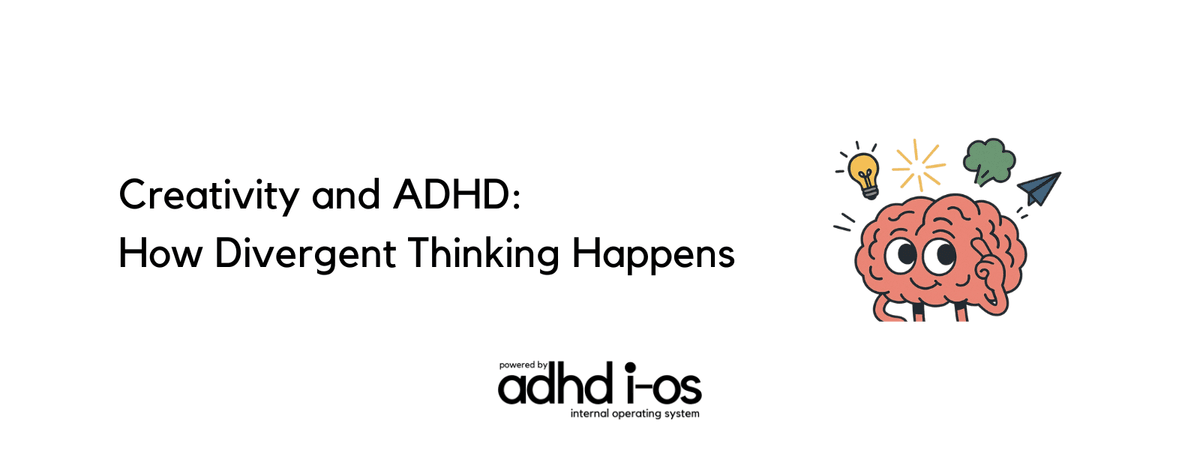Creativity and ADHD: How Divergent Thinking Happens
Creativity and ADHD: How Divergent Thinking Happens
Creativity and ADHD: How Divergent Thinking Happens
Ever had a spark of brilliance… then five more at once?
You’re holding onto a thread of genius, chasing it through your thoughts. And just as you’re trying to capture it, another brilliant idea shows up. Then another. Suddenly, you’re juggling ideas faster than you can record them.
For ADHD brains, that’s not chaos, but creativity. And science backs it up.
Let’s unpack how ADHD supports divergent thinking, or the ability to generate lots of ideas quickly, and what you can do to harness it, not shut it down.

What Is Divergent Thinking?
Divergent thinking is the ability to come up with many possible ideas or solutions from a single starting point. It’s the heart of creativity, innovation, storytelling, and big-picture strategy.
While neurotypical systems often value convergent thinking (narrowing toward a single solution), ADHD brains excel at idea generation. But they can also struggle with filtering, prioritizing, or finishing.
The ADHD Brain: Wired for Creative Thinking
Neuroscience shows that ADHD brains are literally structured for novel, expansive, and nonlinear thinking.
More Distributed Neural Networks
Instead of activating isolated brain regions, ADHD brains fire across broader networks, especially the default mode network (DMN), known for imagination and association.
This lets your brain make unexpected connections, which is ideal for innovation, creativity, and ideation.
Reduced Cognitive Filtering
The prefrontal cortex in ADHD brains is less likely to block out “unusual” thoughts. That’s a superpower for creativity; it means you’re more open to novel ideas and patterns others miss.
Dopamine and Curiosity
ADHD brains crave stimulation. When something sparks curiosity, dopamine surges, and that surge fuels imagination, exploration, and persistence with creative tasks.
The Strength…and the Challenge
Strengths of Divergent Thinking
- Sparks innovation, storytelling, and unconventional problem-solving
- Provides rapid-fire idea generation when stuck in linear thinking
- Helps connect unrelated dots in a unique way
Challenges ADHDers Report
- Idea overwhelm — too many sparks, not enough focus
- Difficulty finishing or narrowing down
- Trouble translating nonlinear thinking into linear communication
ADHD-Friendly Tools to Support Creative Thinking
Instead of shutting down the stream, redirect it. Here are five practical ways to work with your creative ADHD brain:
Strategy - Idea Dumps
Why It Helps - Offload all your thoughts to avoid mental clutter or distraction
Strategy - Park the Spark
Why It Helps - Keep an “exciting but later” list so ideas don’t hijack your current task
Strategy - Creative Zones
Why It Helps - Set a specific time/place to let your creativity roam freely
Strategy - Co-Creation
Why It Helps - Brainstorming with others adds momentum and helps clarify fuzzy ideas
Strategy - Visual Aids
Why It Helps - Mind maps, sticky notes, and sketches help organize nonlinear thoughts visually
You’re Not “Too Much.” You’re Wired for Ideas
If your brain jumps between ideas, tangents, and lightbulb moments, it doesn’t mean you’re broken. It means you’re divergent. And divergent doesn’t need to be fixed. It needs to be channeled.
With the right tools, your wild ideas become innovative solutions. Your sparks become stories. Your chaos becomes creative firepower.
Try This Today
Pick one creativity-friendly habit to experiment with this week:
Do a brain-dump before a big task
- Create a “later list” to park ideas
- Use color-coded stickies or visual maps to organize thoughts
Your brain is wired to create. Honor that.
And join the adhd i-os community for weekly insights, experiments, and tools that don’t fight your brain; they fit it.

